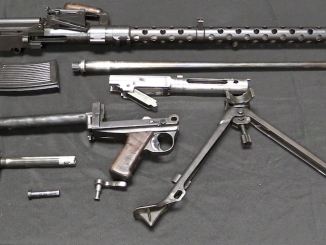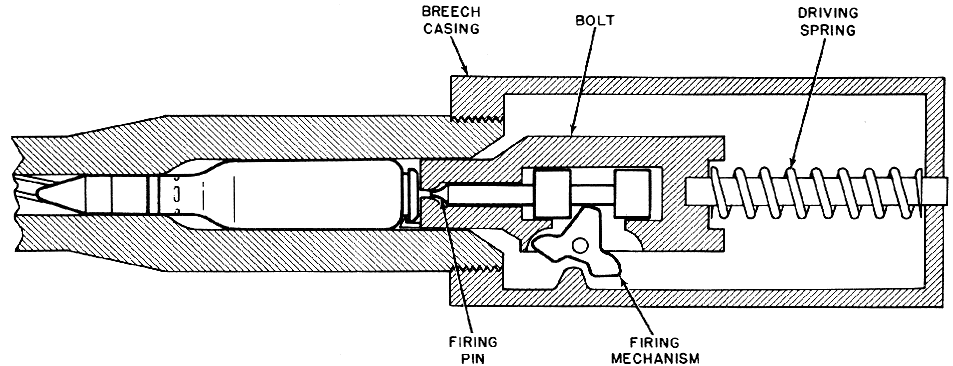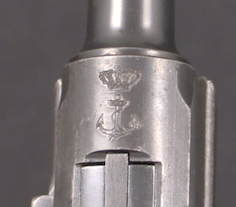Portugal first tested the Luger pistol in 1901, and its commission on self-loading pistols recommended the design for adoption in 1904. No money was available at the time, but a second commission again recommended the Luger in 1907, and it was formally adopted and purchased in 1908. The initial batch was 5,000 pistols chambered for the 7.65mm Parabellum cartridge with 120mm (4.75″) barrels and “M2” crests for then-king Manuel II. They were designated m/908, and numbered from 1 to 5000.
These pistol would satisfy Portuguese Army needs until 1935, then the Garda National Republicana ordered another 564 pistols in the same configuration. These came from Mauser at this point, and had “GNR” crests. These were taken form Mauser commercial production, and have serial numbers between 1900v and 2500v.
The final purchase of Portuguese Army Lugers came in 1943, another 4,578 gun from Mauser. Of course, Germany was deep into the Second World War by this time, and there was no option for Portugal to order its specific configuration. Instead, the Portuguese m/943 pattern was identical to the German standard P08, with the Portuguese guns coming right off the same production line – Waffenamt markings and all. They are numbered between 150m and 5330m.




As a Luger(1916) owner myself, I always welcome Ian’s videos on the multitude of Luger variants.
Excellent! But where are the Closed Captions??
Just an excert from a well done document about Portuguese Luger (credits: Jaime Regalado, author of The Portuguese Parabellum). If you want, I sent you the doc.
Sorry for my awful english and thank you so much for your amazing channel.
The Parabellum Pistol in Portugal
In Portugal, the first trials with the Parabellum pistol, with the aim of equipping the Army officers with an automatic pistol, took place in 1906. The commission of artillery officers appointed for that purpose, chaired by Colonel Matias Nunes, was unanimous in recognizing that this weapon was the one that best satisfied the proposed requirements, both in terms of ballistics and of functioning in general. For these tests, 30 Parabellum pistols, model 1900, in 7.65 mm parabellum caliber and with a 120 mm barrel were acquired. The care taken by DWM in the manufacture of these weapons is remarkable because, even for testing purposes, they received the crown and monogram of King Carlos I engraved on the outer surface above the chamber.
Despite the favorable opinion of this committee, due to the proverbial lack of money, its acquisition was not contracted. In 1907, a new commission of artillery officers was appointed to carry out new tests, which corroborated the previous commission’s opinion. It was then decided to purchase these weapons, to replace the Abadie revolver for Officers, with approximately 50 units having been ordered immediately for some officers who, in that same year, were marching to the south of Angola for the Kwamatos Campaign. The urgency of this acquisition led DWM to supply weapons it had ready-made, destined for the civilian market. These guns, however already of the 1906 model, are technically identical to those that would later be supplied, by contract, but without a monogram and crown and with serial numbers close to 25 000 [Jones] according to civil numbering.
Only in 1908, during the reign of King Manuel II, was the order formalized for 3,500 Parabellum pistols and respective accessories. The first delivery of these weapons took place in mid-1908, extending the supply until mid-1910. Again, this was not the 1900 model used in the tests, but the 1906 model, with some significant improvements over the first. These weapons, also in 7.65 parabellum caliber (.30 Luger), have a barrel of 120 mm, with 4 grooves, right-handed, with a pitch of 250 mm and a depth of 0.125 mm. The crown and monogram of D. Manuel II are engraved on the outer surface of the shooting chamber, and the inscription DWM is engraved on the surface of the back brace of the knee brace, in intertwined letters decorated with arabesques.
On the left side of the extractor, on the polished surface, the word “CARREGADA” is engraved, which is visible only when ammunition is inserted in the firing chamber. The numbering is available in the conventional sites adopted by the DWM for the numbering of contracted weapons, that is, they have the complete number on the barrel and on the front face of the handle. In the remaining main parts, only the last two digits of the serial number appear. This numbering, used by the DWM for contracted weapons, provided that the numbering would start at 1 with the first weapons supplied and, in subsequent acquisitions, by the same entity, the numbering would continue sequentially, thus having each country or force, a number own and independent. In this case, the numbering falls within the range between 1 and 3500, as would be expected in this contract situation. These guns received the official designation of “Pistola Parabellum 7.65 mm m/1908”. All inscriptions described so far, some specifically for Portuguese weapons, were applied in the DWM. In addition to these, there is also a Portuguese verification punch, applied by the reception committee, consisting of an equilateral triangle circumscribed by a circle, placed on the rear face of the handle and on the left face of the outer surface of the firing chamber and on the base of the chargers.
These weapons are a clear example of the good quality of workmanship and finishes (namely the characteristic oxidized ones) of the DWM from the period before the 1st World War. Subsequently, the Portuguese Navy also armed its officers with Parabellum pistols, replacing the ADAMS Mod. 1877 revolver (already in central fire) and the Abadie revolver. There are no known references to the tests carried out by the Navy, however, on 22nd November 1909, a new contract was established between DWM and the Portuguese Government for the supply of 350 Parabellum model 1906 pistols, in 9 mm parabellum caliber, with 100 mm barrel, as well as the respective accessories which consisted of 350 leather holsters, 350 leather double chargers, 350 brushes and 2000 smokeless powder ammunition for a total value of 32,260 French Francs. These weapons were supplied within three months of the aforementioned contract. On the outer surface of the chamber, navy pistols are engraved with an anchor surmounted by a crown and, as in the Army model, the initials DWM, engraved on the anterior brace of the knee brace, as well as the inscription “LOADED” on the left side of the extractor.
All these inscriptions as well as the serial number were placed at the DWM factory. The numbering of these weapons is between 1 and 350, as it is an independent contract from that established with the Army. In these weapons there is also a Portuguese verification proofmark composed by the letters MP, which will certainly mean the Portuguese Navy (Marinha Portuguesa). Likewise, on the thumb safety lever there is no inscription but only the polished surface with the contour of the lever itself. The caliber is engraved on the wooden base of the magazines for these weapons. These weapons took on the official designation of “Pistola Parabellum m/910”.
Firearms Field Strip
#firearmsfieldstripYT
“(…)and “M2” crests for then-king Manuel II(…)”
I would rather except MII (Roman numeral) rather than M2 here. Did kings of Portugal used arabic numerals rather than Roman like other European of that time?
Portuguese kings used roman numerals in the denomination, but interestingly, the symbol on the weapon has a 2 instead of a II.
You can also see it here: https://studio.youtube.com/video/nKvjfg4LhA8/edit
correction: here https://youtu.be/nKvjfg4LhA8
Probably because he is “Manuel II” but not “Manuel 1002”. 😉
Good one. 😉 Or he just thought it looked better. Cyphers, badges, banners and coats of arms are of course also a matter of personal tastes. They represent a person after all.
Coupla comments
1) What you are calling a “crest” is actually called a “monogram” or “cypher”
https://en.wikipedia.org/wiki/Royal_cypher
2) Portugal had a convoluted relationship with Germany and Britain. It joined thw Allies in WW1, dispatching several divisions to Flanders and fighting the Schutztruppe in Africa
https://en.wikipedia.org/wiki/Portugal_during_World_War_I
In WW2, Churchill stunned the world by invoking the Anglo-Portuguese Treaty of 1376 (!) to justify occupying the Azores in 1943. The Portuguese government agreed
https://en.wikipedia.org/wiki/Anglo-Portuguese_Alliance
Today both nations are members of NATO, with the Portuguese proudly claiming the title of “Britain’s oldest ally”
BTW, about 1/3 of Wellington’s Peninsula Army was Portuguese – he called them, “The fighting cocks of the army” and tried to get some of them sent to join him prior to Waterloo
https://fdocuments.in/document/osprey-men-at-arms-061-the-portuguese-army-of-the-napoleonic-warspdf.html
https://www.amazon.com/Portuguese-Army-Napoleonic-Wars-Men-At-Arms/dp/1855327678
https://www.barnesandnoble.com/w/the-portuguese-army-of-the-napoleonic-wars-rene-chartrand/1103457308
https://www.amazon.com/Portuguese-Army-Napoleonic-Wars-Men-at-Arms/dp/1841761575
Hello guys and welcome to Forgotten Lugers. My name is Ian McLuger… 😉
Nothing wrong with the Parabellumpistole. We need more of this more elegant pistol from a more refined time. Not as clumsy or as blocky as a Glock. Although the Glock pistol has been in service around the world since 1980. It certainly could easily fill a series with all its officially adopted versions.
I’m now the owner of the GNR specimen in the video. Already have an M2 nicer than the one in the video, and was not interested in the m/943 pattern example offered.
Apologies to Mr. McCollum, I do enjoy Your youtube channel.
G.N.R. ( Guarda Nacional Republicana ) Still in operation today.